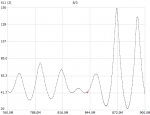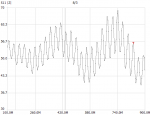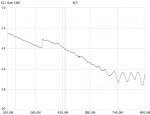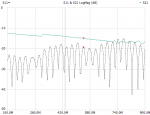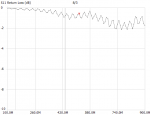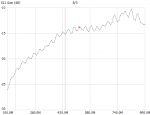All good. It helps to have a decent concept of vector addition, imaginary components of values, etc. So it sounds like you're on the right road.
In the electronics world, the "i" imaginary component of a value as in 3-i5 is replaced with a "j" lower case. The reason is that "i" represents current in electronics engineering, in the lower case usually AC current with a frequency associated with it. So, to avoid confusion, in the electronics engineering field, "i" was replaced with "j". But in mathematical terms, they represent the same thing - the imaginary component of the value. Same basic use of the usual x and y graph but with the origin usually centered or normalized to the system desired impedance which is usually 50 ohms or 75 ohms.
As you may know, when you add vector values you can use either real+imaginary or magnitude and angle approaches.
So, when you see a reference to a "polar plot" when using VNA's that means the presented graph will show a magnitude and phase angle.
I've never been as good at utilizing a polar plot as I am with using a Smith Chart. But you use what you are most comfortable with.
The idea with impedance matching in the RF world is to keep the imaginary part as low as possible (the "reactive" component) and make the resistive part as close to the desired system impedance as possible (50 or 75 ohms typically).
With antennas, you try and get them to present a nice 50 or 75 ohm impedance with small or no reactive component that the transmitter or receiver is designed to work with. The further you get away from that the worse the presented impedance will be relative to 50 or 75 ohms purely resistive.
Most antennas are only "purely resistive" or close to that at their center resonance frequency point. That doesn't mean they won't work well outside of that but usually, depending on the design, it will get worse and worse the further away from the center of resonance.
Depending on the design of the antenna, the loss from impedance mismatch may not be so bad that the gain of the antenna can't significantly overcome it. So a perfect match isn't usually an absolute necessity nor is it practically possible across all frequencies that may be in use for a given antenna.
You should, of course, understand how to calculate wavelength for a given frequency. In case you don't know, in pure form it's the speed of light divided by the frequency. For all practical purposes when dealing with common LMR frequencies that are usually measured in MHz you can reduce and approximate that down to a simple 300/freq. in MHz. But that's still for "in free space" as out there in space. Air here can change things. The usual approximation that tries to fold in compensation for some of this is 468/freq. in MHz for a half wave length. Half wave antennas form the basic starting point for the vast majority of practically usable designs. Your TV rabbit ears is a simple half wave dipole, for example.
A 1/4 wave spike as most handheld and mobile antennas are is a modification of this that uses a (ideally infinite) ground plane as the "second half" of the antenna. For a car that is the metal car body. For a handheld it is the metal casing of the handheld radio (plus, during typical operation, the coupling of your hand to the case of the radio). Generally, while in the air above ground in the form of a base station type antenna, you use ground plane radials to provide the ground plane, the more the better. If the radials are at right angles relative to the radiating 1/4 wave vertical element then the impedance is (I think, as I recall - PRC Guy can correct me if I'm wrong) around thirty-something ohms. But if you bend the radials down to a 45 degree angle relative to the 1/4 wave radiator you get closer to that magical 50 ohms. Another approach, especially at lower frequencies and therefor longer wavelengths, is to mount the vertical 1/4 wave element at ground level and use the actual earth ground as the ground plane. But this really only works best if you also spread out as much radial wires as possible along the ground radiating away from the base of the antenna. Depends on how good the ground resistivity is where you're mounting the antenna. Among other things. Not my area of expertise here so...
A half wave dipole fed in the center presents around a 70 ohm impedance at center resonance. Hence the common use of 75 ohm coaxial cable and baluns for such antennas. A half wave antenna is also a "balanced" design and, to properly attach it to an "unbalanced" lead such as coaxial cable, you should use a "balun" which is short for "balanced to unbalanced". Again, when you have a half wave dipole vertically mounted the "bottom" element is the "other" 1/4 wave "half" of the antenna that the ground plane creates for the 1/4 wave antennas described above. Because a 1/2 wave dipole mounted well above ground has both 1/4 wave elements balanced and symmetrically mirror images of each other a good dipole should out-perform a 1/4 wave ground plane all other things being equal and at the center of resonance. The coax should be fed at a right angle to the antenna meaning that it extends out 90 degrees from the vertical away from the antenna for a vertically polarized arrangement. You don't want to run the coax down parallel to the lower 1/4 wave element nor do you want a metal mast too close to that element. This is why most such designs have an arm at 90 degrees from vertical for mounting to a mast and the coax runs away from the antenna along that arm until again going vertical down the mast.
There is really no need at all for a ground plane for a true half wave dipole mounted in the air. The closer to the ground it gets, though, the more "squashed" the usual "doughnut shaped" approximate torus radiation pattern gets and, I need help here, but I think that you might get more elevation angle to the pattern. Again, I differ to PRC Guy here.
There are other variations like a coaxial sleeve dipole that uses a half wave sleeve for the lower element with the coax running up inside to connect at the junction between the two 1/4 wave elements. No balun is usually needed here as the sleeve effectively "decouples" the unbalanced coax from the radiation of the antenna which is why it is also sometimes called a "decoupling sleeve".
But for small 1/4 wave spikes you really should have a ground plane of some type suitable for the frequency of interest. At low frequencies like CB and VHF low that is really tough. Pretty much impossible due to the long wavelengths of the frequencies. Handheld radios at those frequencies using physically and practically small antennas do not perform very well for that reason. At UHF and up, though, presuming the radio has a decent metal body content, it gets much much better. This is why most modern LMR usage that relies a lot on handheld portable radios is in the VHF high and above frequency ranges. If low band is used, there is often a vehicular repeater that operates in much higher frequency ranges and allows a much higher frequency handheld to connect to the low band mobile radio in the car as in the CHP vehicles here in California.
The body of your portable VNA may have sufficient metal to act as a groundplane for the higher UHF ranges but you should use some extra metal for the lower ranges. About 18 inches in diameter for the VHF-High 150 MHz band for example.
Some UHF and higher handheld antennas, due to the small wavelengths involved, use a coaxial sleeve or end-fed half wave design which may give them a slight improvement over the typical 1/4 wave spike and they also do not need a separate groundplane to work well though it won't hurt them if they also have one.
There are "tricks" that can be used to physically shorten a 1/4 wave antenna to smaller sizes and still make them work sort of ok. They usually involve some kind of "loading" which amounts to a form of impedance matching to make the antenna "appear" to be electrically equivalent to a real 1/4 wave to the radio. Most handheld "rubber ducks" use a "continuous loading" which amounts to a helical wound wire all along the length of the antenna to allow, for example, a VHF-High 155 MHz 18 inch 1/4 wave to be reduced to a total physical length of 6 inches or so. Needless to say, this results in a negative gain compromise solution but it works well enough when properly implemented in a moderate to strong signal environment. Mobile car antennas have a little more flexibility and can use base and center loading coils which you often see when physical size needs to be reduced. Top loading is possible, as well, but seldom used due to mechanical issues posed by such designs mounted on moving vehicles with wind loads at speed.
Your VNA isn't being "tricked" when you "added a ground". That's simply what it is. Some kind of ground plane versus no ground plane at all are going to yield different results for a given 1/4 wave based antenna design.
Something else to know - though proper impedance matching is very important to transmitter amplifiers as you want the maximum power from the amplifier delivered to the antenna, it is really less so for receivers. It's a question of "small signal amplifier design" versus "power amplifier design" Two different beasts, believe me!
In general, for receivers, the main idea is to get the most signal voltage level (not power as with a transmitter) into the small signal receiver amplifiers as possible. Unlike with power amplifiers in transmitters, if you look at the math, in theory you could have a very high impedance receiver antenna port relative to the antenna and that should provide maximum voltage level. But for various reasons, including the effect of the characteristic impedance of the coaxial cable used, amount of noise in the system, and the simple fact that you are making a design that uses a single port for the antenna connection for both the transmitter and the receiver in a typical transceiver you generally still stick to designing around a common 50 ohm resistive ideal design point for both the transmitter and the receiver. So in the RF world impedance matching is the name of the game for both transmission and reception. But you do still see high impedance antenna ports on some receivers such as low frequency short wave (HF and lower) receivers and these ports are typically attached to random wire antennas like "long wires" that are not "matched" to the receiver.
But for broad band large frequency range VHF and above receivers like your typical scanner, I assure you that if you were to connect your VNA to your antenna port of the scanner (careful if you do this as you don't want the level of the test signal from the VNA to overload or damage your radio!) it is unlikely that you would see a nice perfect 50 ohm load impedance at any frequency within its designed for range let alone along the entire radio frequency coverage! The design criteria for wideband receivers is usually to make the receiver work well when connected to a low impedance unbalanced source like a typical 50 ohm based antenna. That does not at all mean that the load impedance of the receiver's first stage amplification (or in some cases the first mixer itself but usually with some kind of buffer amp ahead of it) will present a true 50 ohm resistive load to an incident signal. So don't be either surprised or alarmed if you do this and see some weird non-50 ohm resistive result at the antenna port of your favorite receiver no matter what frequency you choose to tune it to. And, by the way, if you do do this make sure to turn the receiver on as most amplifiers and other active devices will present very different load characteristics to an incident signal when powered off versus when powered on.
-Mike



